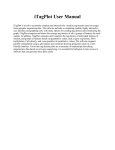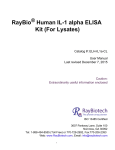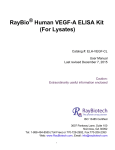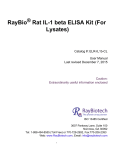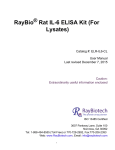Download User Manual - RayBiotech, Inc.
Transcript
RayBio® Human GITR ELISA Kit (For Lysates) Catalog #: ELH-GITR-CL User Manual Last revised December 7, 2015 Caution: Extraordinarily useful information enclosed ISO 13485 Certified 3607 Parkway Lane, Suite 100 Norcross, GA 30092 Tel: 1-888-494-8555 (Toll Free) or 770-729-2992, Fax:770-206-2393 Web: www.RayBiotech.com, Email: [email protected] 1 RayBiotech, Inc. ________________________________________ RayBio® Human GITR ELISA Kit (For Lysates) Protocol Table of Contents Section Page # I. Introduction 3 II. Storage 4 III. Reagents 4 IV. Additional Materials Required 4 V. Reagent Preparation 5 VI. Assay Procedure 6 VII. Assay Procedure Summary 7 VIII. Calculation of Results A. Typical Data B. Sensitivity C. Spiking & Recovery D. Linearity E. Reproducibility 8 8 8 9 9 10 IX. Specificity 10 X. Troubleshooting Guide 11 Please read the entire manual carefully before starting your experiment 2 I. INTRODUCTION GITR (glucocorticoid induced tumor necrosis factor receptor family related gene) is a type-1 transmembrane protein of 228 amino acids belonging to the TNF and NGF receptor family of proteins. GITR is expressed in normal T-lymphocytes from thymus, spleen. Constitutive expression of a transfected GITR gene induces resistance to apoptosis induced by anti CD3 monoclonal antibodies. The human homolog of GITR is expressed in lymph node and peripheral blood leukocytes. Its expression is up-regulated in human peripheral mononuclear cells mainly after stimulation with antibodies against CD3 and CD28. The RayBio® Human GITR ELISA kit is an in vitro enzyme-linked immunosorbent assay for the quantitative measurement of human GITR in cell lysate and tissue lysate. This assay employs an antibody specific for human GITR coated on a 96well plate. Standards and samples are pipetted into the wells and GITR present in a sample is bound to the wells by the immobilized antibody. The wells are washed and biotinylated anti-human GITR antibody is added. After washing away unbound biotinylated antibody, HRP- conjugated streptavidin is pipetted to the wells. The wells are again washed, a TMB substrate solution is added to the wells and color develops in proportion to the amount of GITR bound. The Stop Solution changes the color from blue to yellow, and the intensity of the color is measured at 450 nm. 3 II. STORAGE The entire kit may be stored at -20°C for up to 1 year from the date of shipment. Avoid repeated freeze-thaw cycles. The kit may be stored at 4°C for up to 6 months. For extended storage, it is recommended to store at -80°C. For prepared reagent storage, see table below. III. REAGENTS Component Size / Description Storage / Stability After Preparation GITR Microplate (Item A) 96 wells (12 strips x 8 wells) coated with antiHuman GITR. 1 month at 4°C* Wash Buffer Concentrate (20X) (Item B) 25 ml of 20X concentrated solution. 1 month at 4°C Standard Protein (Item C) 2 vials of Human GITR. 1 vial is enough to run each standard in duplicate. 1 week at -80°C Detection Antibody GITR (Item F) 2 vials of biotinylated anti-Human GITR. Each vial is enough to assay half the microplate. 5 days at 4°C HRP-Streptavidin Concentrate (Item G) 200 µl 400X concentrated HRP-conjugated streptavidin. Do not store and reuse. TMB One-Step Substrate Reagent (Item H) 12 ml of 3,3,5,5'-tetramethylbenzidine (TMB) in buffer solution. N/A Stop Solution (Item I) 8 ml of 0.2 M sulfuric acid. N/A Sample Diluent Buffer (Item D2) 10 ml of 5X concentrated buffer. 1 month at 4°C Assay Diluent (Item E2) 15 ml of 5X concentrated buffer. 1 month at 4°C Cell lysate buffer (Item J) 5 ml of 2X cell lysate buffer. 1 month at 4°C *Return unused wells to the pouch containing desiccant pack, reseal along entire edge. IV. ADDITIONAL MATERIALS REQUIRED 1. 2. 3. 4. 5. 6. 7. 8. Microplate reader capable of measuring absorbance at 450 nm. Precision pipettes to deliver 2 µl to 1 ml volumes. Adjustable 1-25 ml pipettes for reagent preparation. 100 ml and 1 liter graduated cylinders. Absorbent paper. Distilled or deionized water. Log-log graph paper or computer and software for ELISA data analysis. Tubes to prepare standard or sample dilutions. 4 V. REAGENT PREPARATION 1. Bring all reagents and samples to room temperature (18 - 25ºC) before use. 2. Sample Diluent Buffer (Item D2) and Assay Diluent (Item E2) should be diluted 5-fold with deionized or distilled water before use. Cell lysate buffer (Item J) should be diluted 2-fold with deionized or distilled water (for cell lysate and tissue lysate). 3. Sample dilution: Tissue lysate and cell lysate samples should be diluted at least 5-fold with 1X Sample Diluent Buffer (Item D2). Generally we recommend a minimum of 1 mg of protein per 1 ml of original lysate solution, though more concentrated is better. We also recommend the addition of protease inhibitors (not included) to the lysis buffer prior to use. Detailed recommendations on lysis preparation may be found here: www.raybiotech.com/tips-on-samplepreparation.html Note: Levels of GITR may vary between different samples. Optimal dilution factors for each sample must be determined by the investigator. 4. Preparation of standard: Briefly spin a vial of Item C. Add 400 µl 1X Sample Diluent Buffer (Item D2) into Item C vial to prepare a 100 ng/ml standard. Dissolve the powder thoroughly by a gentle mix. Add 60 µl GITR standard from the vial of Item C, into a tube with 540 µl 1X Sample Diluent Buffer to prepare a 10,000 pg/ml stock standard solution. Pipette 400 µl 1X Sample Diluent Buffer into each tube. Use the stock standard solution to produce a dilution series (shown below). Mix each tube thoroughly before the next transfer. 1X Sample Diluent Buffer serves as the zero standard (0 pg/ml). 5 5. If the Wash Concentrate (20X) (Item B) contains visible crystals, warm to room temperature and mix gently until dissolved. Dilute 20 ml of Wash Buffer Concentrate into deionized or distilled water to yield 400 ml of 1X Wash Buffer. 6. Briefly spin the Detection Antibody vial (Item F) before use. Add 100 µl of 1X Assay Diluent (Item E2) into the vial to prepare a detection antibody concentrate. Pipette up and down to mix gently (the concentrate can be stored at 4ºC for 5 days). The detection antibody concentrate should be diluted 80fold with 1X Assay Diluent (Item E2) and used in step 5 of Part VI Assay Procedure. 7. Briefly spin the HRP-Streptavidin concentrate vial (Item G) and pipette up and down to mix gently before use, as precipitates may form during storage. HRPStreptavidin concentrate should be diluted 400-fold with 1X Assay Diluent (Item E2). For example: Briefly spin the vial (Item G) and pipette up and down to mix gently. Add 30 µl of HRP-Streptavidin concentrate into a tube with 12 ml 1X Assay Diluent to prepare a 400-fold diluted HRP-Streptavidin solution (don't store the diluted solution for next day use). Mix well. VI. ASSAY PROCEDURE 1. Bring all reagents and samples to room temperature (18 - 25ºC) before use. It is recommended that all standards and samples be run at least in duplicate. 2. Label removable 8-well strips as appropriate for your experiment. 3. Add 100 µl of each standard (see Reagent Preparation step 3) and sample into appropriate wells. Cover well and incubate for 2.5 hours at room temperature or over night at 4ºC with gentle shaking. 4. Discard the solution and wash 4 times with 1X Wash Solution. Wash by filling each well with Wash Buffer (300 µl) using a multi-channel Pipette or autowasher. Complete removal of liquid at each step is essential to good performance. After the last wash, remove any remaining Wash Buffer by aspirating or decanting. Invert the plate and blot it against clean paper towels. 6 5. Add 100 µl of 1X prepared biotinylated antibody (Reagent Preparation step 6) to each well. Incubate for 1 hour at room temperature with gentle shaking. 6. Discard the solution. Repeat the wash as in step 4. 7. Add 100 µl of prepared Streptavidin solution (see Reagent Preparation step 7) to each well. Incubate for 45 minutes at room temperature with gentle shaking. 8. Discard the solution. Repeat the wash as in step 4. 9. Add 100 µl of TMB One-Step Substrate Reagent (Item H) to each well. Incubate for 30 minutes at room temperature in the dark with gentle shaking. 10. Add 50 µl of Stop Solution (Item I) to each well. Read at 450 nm immediately. VII. ASSAY PROCEDURE SUMMARY 1. Prepare all reagents, samples and standards as instructed. 2. Add 100 µl standard or sample to each well. Incubate 2.5 hours at room temperature or over night at 4ºC. 3. Add 100 µl prepared biotin antibody to each well. Incubate 1 hour at room temperature. 4. Add 100 µl prepared Streptavidin solution. Incubate 45 minutes at room temperature. 5. Add 100 µl TMB One-Step Substrate Reagent to each well. Incubate 30 minutes at room temperature. 6. Add 50 µl Stop Solution to each well. Read at 450 nm immediately. 7 VIII. CALCULATION OF RESULTS Calculate the mean absorbance for each set of duplicate standards, controls and samples, and subtract the average zero standard optical density. Plot the standard curve on log-log graph paper or using Sigma plot software, with standard concentration on the x-axis and absorbance on the y-axis. Draw the best-fit straight line through the standard points. A. TYPICAL DATA These standard curves are for demonstration only. A standard curve must be run with each assay. B. SENSITIVITY The minimum detectable dose of Human GITR was determined to be 15 pg/ml. Minimum detectable dose is defined as the analyte concentration resulting in an absorbance that is 2 standard deviations higher than that of the blank (diluent buffer). 8 C. SPIKING & RECOVERY Recovery was determined by spiking various levels of Human php echo GITR into the sample types listed below. Mean recoveries are as follows: D. LINEARITY 9 E. REPRODUCIBILITY Intra-Assay CV%: <10% Inter-Assay CV%: <12% IX. SPECIFICITY The antibody pair provided in this kit recognizes human GITR / TNFRSF18. 10 X. TROUBLESHOOTING GUIDE Problem Cause Solution Poor standard curve Inaccurate pipetting Improper standard dilution Check pipettes Briefly centrifuge Item C and dissolve the powder thoroughly by gently mixing Low signal Improper preparation of standard and/or biotinylated antibody Too brief incubation times Inadequate reagent volumes or improper dilution Briefly spin down vials before opening. Dissolve the powder thoroughly. Ensure sufficient incubation time; assay procedure step 2 may be done overnight Check pipettes and ensure correct preparation Large CV Inaccurate pipetting Air bubbles in wells Check pipettes Remove bubbles in wells High background Plate is insufficiently washed Contaminated wash buffer Review the manual for proper wash. If using a plate washer, ensure that all ports are unobstructed. Make fresh wash buffer Improper storage of the ELISA kit Stop solution Store your standard at <-70ºC after reconstitution, others at 4ºC. Keep substrate solution protected from light. Add stop solution to each well before reading plate Low sensitivity 11 RayBio® ELISA Kits Over 2,000 ELISA kits available, visit www.RayBiotech.com/ELISA-Kits.html for details. This product is for research use only. ©2015 RayBiotech, Inc 12












